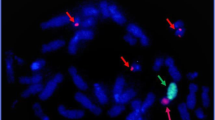Abstract
Objective
To describe clinical features in Indian girls with Turner syndrome along with the phenotype-karyotype correlation.
Methods
103 girls with Turner syndrome were divided into karyotype-groups: Classic (45X), 45,X/46,XX mosaics, isochromosomeXq (46,X,iXq and 45,X/46,X,iXq mosaics), 45,X/46,XYmosaics and structural defects, and analyzed for phenotypic differences.
Results
Majority (44.1%) had classic karyotype followed by isochromosome-Xq (26.5%). Classic Turner syndrome had higher prevalence of most skeletal and cutaneous stigmata, cubitus valgus (68.3%) and multiple nevi (68.2%) being the commonest. Bicuspid aortic valve was most common in 45,X/46,XX mosaics (5/15, 33.3%), and aortic coarctation in classic TS (3/42, 7.2%). Congenital renal anomalies occurred mostly in classic TS (6/42,14.3%). Overt hypothyroidism, conductive deafness and recurrent otitis media were commonest in isochromosomes (P<0.03). 45,X/46,XY mosaics had highest IQ (P<0.005).
Conclusion
We report some novel associations of karyotype with non-endocrine parameters in Turner syndrome. In resource-limited settings, underlying karyotype may help prioritize screening investigations in girls with Turner syndrome.
Similar content being viewed by others
References
Bondy CA, Turner Syndrome Consensus Study Group. Care of Girls and Women With Turner Syndrome: A Guideline of the Turner Syndrome Study Group. J Clin Endocrinol Met. 2007;92:10–25.
Gravholt CH, Andersen NH, Conway GS, et al. Clinical Practice Guidelines for the Care of Girls and Women With Turner Syndrome: Proceedings From the 2016 Cincinnati International Turner Syndrome Meeting. European J Endocrinol. 2017;177:G1–70
Cameron-Pimblett A, La Rosa C, King TF, Davies MC, Conway GS. The Turner syndrome life course project: Karyotype-phenotype analyses across the lifespan. Clinical endocrinology. 2017;87:532–8.
Zelinska N, Shevchenko I, Globa E. Nationwide study of Turner syndrome in Ukrainian children: prevalence, genetic variants and phenotypic features. J Clin Res Pediatr Endocrinol. 2018;10:256.
Al Alwan I, Khadora M, Amir I, et al. Turner syndrome genotype and phenotype and their effect on presenting features and timing of diagnosis. Int J Health Sci. 2014;8:19.
Maiti A, Chatterjee S. Turner syndrome: Fifteen years’ experience in India. J Obs Gynec India. 2014;64:121–3.
Suri M, Kabra M, Jain U, et al. A clinical and cytogenetic study of Turner syndrome. Indian Pediatr. 1995;32:433–9.
Shaffer LG, Tommerup N, editors. ISCN 2005: An International System for Human Cytogenetic Nomenclature (2005): Recommendations of the International Standing Committee on Human Cytogenetic Nomenclature. Karger Medical and Scientific Publishers; 2005.
Kosho T, Muroya K, Nagai T, et al. Skeletal features and growth patterns in 14 patients with haploinsufficiency of SHOX: Implications for the development of Turner syndrome. J Clin Endocrinol Metab. 1999;84:4613–21.
Malin AJ. Manual for Malin’s intelligence scale for Indian children (MISIC) 1969. Indian Psychological Corporation.
Ye∘ilkaya E, Bereket A, Darendeliler F, et al. Turner syndrome and associated problems in Turkish children: A multicenter study. J Clin Res Pediatr Endocrinol. 2015; 7:27.
Miyabara S, Sugihara H, Maehara N, et al. Significance of cardiovascular malformations in cystic hygroma: A new interpretation of the pathogenesis. Am J Med Genet. 1989; 34:489–501.
Mortensen KH, Andersen NH, Gravholt CH. Cardiovascular phenotype in Turner syndrome — Integrating cardiology, genetics, and endocrinology. Endocr Rev. 2012;33:677–714.
Nazarabadi HM, Seyyedi S, Aboutorabi R. Effects of karyotype variations on phenotype of patients with Turner syndrome. Iranian J Med Sci. 2005;30:182–5.
Ross J, Zinn A, McCauley E. Neurodevelopmental and psychosocial aspects of Turner syndrome. Mental Retard Dev Disab Res Rev. 2000;6:135–41.
Acknowledgements
Dr Dinesh Munian, Assistant Professor, IPGME&R, Kolkata and Dr Ajanta Halder, Professor, Department of Genetics, Vivekananda Institute of Medical Sciences, Kolkata for their opinion on karyotypes of the patients. Dr Pradip Mukhopadhyay for his support with the statistical analysis.
Author information
Authors and Affiliations
Corresponding author
Additional information
Ethics clearance
Institutional ethics committee of IPGME&R, Kolkata; No. IPGME&R/IEC/2017/098, dated February 16, 2017.
Contributors
SM: acquisition of data, analysis of raw data with interpretation and formulating the initial draft; RB: contributed to data collection, analysis and revising the draft; SC: contributed to the concept and design of the project and critical analysis of the data and draft; SM: was chiefly involved in data analysis, revising the data and draft critically for important intellectual content. All authors approved the final version of the manuscript.
Funding
None
Competing interest
None stated.
Rights and permissions
About this article
Cite this article
Mondal, S., Bhattacharjee, R., Chowdhury, S. et al. Karyotype-Phenotype Correlation in Turner Syndrome at a Single Center in Eastern India. Indian Pediatr 58, 34–37 (2021). https://doi.org/10.1007/s13312-021-2093-x
Received:
Revised:
Accepted:
Published:
Issue Date:
DOI: https://doi.org/10.1007/s13312-021-2093-x




